仁爱英语初一上册unit4 t opic3 sectionD 导学案
仁爱版英语七年级上册Unit4Topic3SectionD教学设计
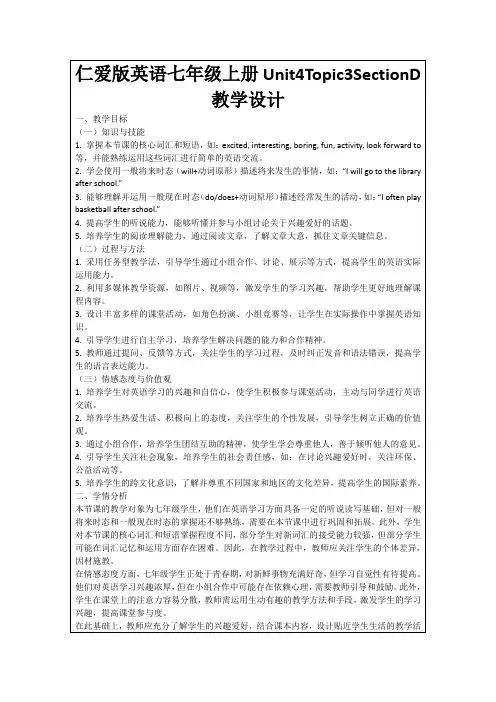
五、作业布置
为了巩固本节课所学知识,培养学生的自主学习能力,特布置以下作业:
1.书面作业:
(1)完成课后练习册中与本节课相关的练习题,加深对一般将来时态和一般现在时态的理解。
(2)根据课堂所学,写一篇小短文,描述自己的兴趣爱好和未来的计划,要求使用一般将来时态和一般现在时态。
4.引导学生关注社会现象,培养学生的社会责任感,如:在讨论兴趣爱好时,关注环保、公益活动等。
5.培养学生的跨文化意识,了解并尊重不同国家和地区的文化差异,提高学生的国际素养。
二、学情分析
本节课的教学对象为七年级学生,他们在英语学习方面具备一定的听说读写基础,但对一般将来时态和一般现在时态的掌握还不够熟练,需要在本节课中进行巩固和拓展。此外,学生对本节课的核心词汇和短语掌握程度不同,部分学生对新词汇的接受能力较强,但部分学生可能在词汇记忆和运用方面存在困难。因此,在教学过程中,教师应关注学生的个体差异,因材施教。
3.引导学生回顾已学过的一般现在时态,为新学的一般将来时态做好过渡。
(二)讲授新知(500字)
1.教师呈现新课的词汇和短语,如:excited, interesting, boring, fun, activity, look forward to等,通过图片、例句等形式,帮助学生理解和记忆。
2.介绍一般将来时态(will+动词原形),用生动的例子和情景,引导学生学会用将来时态描述将要发生的事情。
(4)巩固练习:设计针对性的练习题,巩固所学知识,提高学生的实际运用能力。
2.教学策略:
(1)分层教学:针对学生的个体差异,设计不同难度的教学任务,使每个学生都能在课堂上得到锻炼。
Unit4Topic3 SectionD 教案仁爱版七年级英语上册
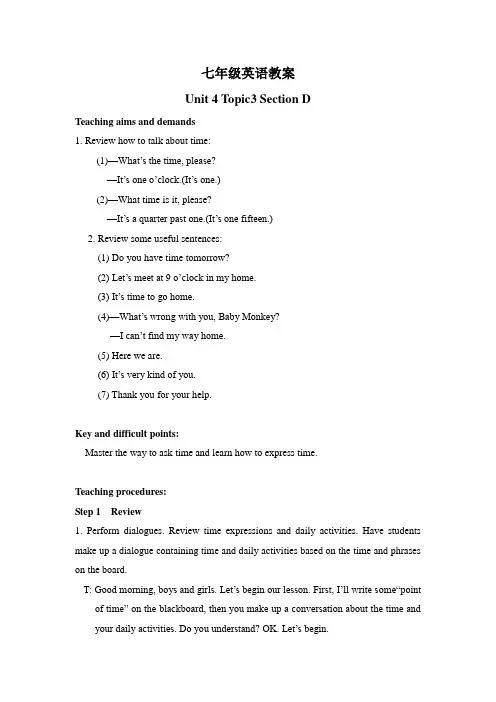
七年级英语教案Unit 4 Topic3 Section DTeaching aims and demands1. Review how to talk about time:(1)—What’s the time, please?—It’s one o’clock.(It’s one.)(2)—What time is it, please?—It’s a quarter past one.(It’s one fifteen.)2. Review some useful sentences:(1) Do you have time tomorrow?(2) Let’s meet at 9 o’clock in my home.(3) It’s time to go home.(4)—What’s wrong with you, Baby Monkey?—I can’t find my way home.(5) Here we are.(6) It’s very kind of you.(7) Thank you for your help.Key and difficult points:Master the way to ask time and learn how to express time.Teaching procedures:Step 1 Review1. Perform dialogues. Review time expressions and daily activities. Have students make up a dialogue containing time and daily activities based on the time and phrases on the board.T: Good morning, boys and girls. Let’s begin our lesson. First, I’ll write some“point of time” on the blackboard, then you make up a conversation about the time and your daily activities. Do you understand? OK. Let’s begin.S1: What’s the time?S2: It’s ten to seven.S1: It’s time to get up.Step 2 Presentation1. The teacher writes the example words of 1 on the board and asks the students to read the words and pay attention to the pronunciation of the letter combinations in the underlined part.T: Nice work. Boys and girls, today let’s go on learning some phonetics. First, read these words together. Then tell me what they pronounce.2.Listen to the recording and students read along with 1.T: OK. Now listen to 1 and repeat.Step 3 ConsolidationConsolidate phonetic symbols and complete 2. Train students' listening and speaking skills.1. Group Activity. Divide the class into four groups. To add words to the above phonetic symbols, look up the dictionary.T: Now let’s read these words, please.2. (1)Listen to the recording and write the time in Arabic numerals.(2)Ask students to orally describe Michael' s daily life, review the third person singular form of the general present tense, and reinforce time expressions.Step 4 Practice1. Listen to the recordings of 3a and 3b and ask students to repeat the sentences they hear without looking at the book. Complete 3a and 3b.T: Nice work! Now, l et’s listen to the tape and retell what you hear. Please close your books. Ready? Go!2. Review what you have learned about this topic through written exercises.T: OK, let’s do some exercises to review what we’ve learnt in this topic.(1)The small blackboard presents the exercise.(2)Students check their answers when they are finished.Step 5 Summary(1) Do you have time tomorrow?(2) Let’s meet at 9 o’clock in my home.(3) It’s time to go home.(4)—What’s wrong with you, Baby Monkey?—I can’t find my way home.(5) Here we are.(6) It’s very kind of you.(7) Thank you for your help.Step 6 Homework(1)Summarize the target language of the lesson.(2)Write a short essay about a day in the life of yourself or a friend. If the subject isin the third person singular, note the third person singular form of the general present tense.。
仁爱版七年级英语上册Unit4__Topic3__Section__D精品导学案

(Unit4 Topic3 Section D精品导学案学习目标1、知识学习双音节组合的拼读方法~。
2、方法(直观法)直接告诉学生是有一个单元音滑向另一个元音。
3、情感归纳总结本话题的主要内容,让学生自己互相交流本话题学完后的情感触动。
学习重点:掌握单元音和双元音的发音技巧和写法,掌握一般现在时。
学习难点及突破策略:学习难点:单元音和双元音的发音规律。
突破策略:找出与此相关的音标、拼读单词。
学习流程:【阅读质疑自主探究】一、走入新课1、复习自己一天的主要活动,并用到下面该词组:Get up \ go to school \ have lunch \ have classes \ play football \Go home \ have dinner2、Listen to the table write down the time then finish P99 2。
3、总结本话题的重要句型,知识点。
二、阅读提示:1、让大家分别看P99 1 音标,自己总结出哪些字母组合发什么音,如:ear \eer \ea- [iə]2、让学生自己回忆以前学过的单词中哪些单词的字母组合发:[iə] \ [uə] \ [כi] \ 逐一完成。
3、轻松一下,sing a song 。
<Good Night>【多元互动合作探究】1、请你将你自己不理解的问题与周边同学交流探讨,注意听取他人意见并将你认为有价值的记录下来。
2、同桌之间互相提问、练习。
【训练检测目标探究】用所给单词的适当形式填空:(1)It’s time for us (clean) room..(2) It’t very kind of you (help) us.(3) Mr wang (teach)Chinese is our school.(4) Michacl lives in (English).(5) My father often (go)to bed at 11:30.【迁移运用,拓展探究】一、学习连接1课下收集一些关于动物的谚语,如:He always works like a tiger.Michael is a cock of the school now .Love me \ love my dog.二、学习连接2总结单词的发音技巧。
新仁爱版七年级英语上册Unit 4 Topic 3 SectionD 学案
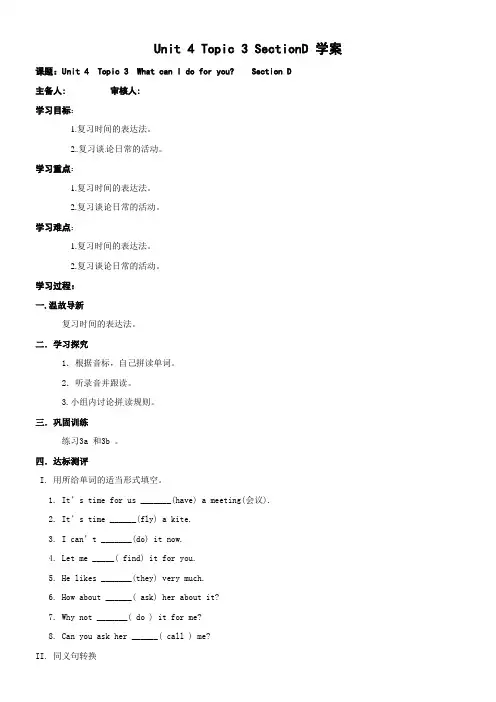
Unit 4 Topic 3 SectionD 学案课题:Unit 4 Topic 3 What can I do for you? Section D主备人: 审核人:学习目标:1.复习时间的表达法。
2.复习谈论日常的活动。
学习重点:1.复习时间的表达法。
2.复习谈论日常的活动。
学习难点:1.复习时间的表达法。
2.复习谈论日常的活动。
学习过程:一.温故导新复习时间的表达法。
二.学习探究1.根据音标,自己拼读单词。
2.听录音并跟读。
3.小组内讨论拼读规则。
三.巩固训练练习3a 和3b 。
四.达标测评I. 用所给单词的适当形式填空。
1. It’s time for us _______(have) a meeting(会议).2. It’s time ______(fly) a kite.3. I can’t _______(do) it now.4. Let me _____( find) it for you.5. He likes _______(they) very much.6. How about ______( ask) her about it?7. Why not _______( do ) it for me?8. Can you ask her ______( call ) me?II. 同义句转换1. He often goes to school at seven fifteen.He often goes to school at ________ ________ ________ ______.2. I can’t write this letter, I have not a pen.I can’t write this letter, I have ________ pen3. I have no erasers.I have _______ _______erasers.4. What an imal do you like best?What is your _______ animal?5. What time is it? What is _______ time?III. 单项选择1. The monkey is very _______. I like it very much.A. goodB. cuteC. niceD. tired2. What’s wrong ______you? You look very bad.A. atB. ofC. withD. for3. ___, let’s get of f the bus.A. He re you areB. Here we areC. Here it isD. Here are we4. Can you find the way ________?A. homeB. to homeC. go homeD. going home5. ---Do you have _______apples?---Yes, I have _________.A. any; anyB. some; someC. any; someD. some; anyt6.It’s time now.A. go to schoolB. go homeC. to go the homeD.to go to the zoo7.---Excuse me. What is the English f or “11:45” ? ---It’s .A.a quarter past twelveB.a quarter to twelveC.eleven past forty-fiveD.twelve to fifteen8.It’s a quarter t hree.A. pastB. atC. toD.A and CIV. 补全对话A: I see a boy crying.B: ___1____?A: Over ___2____.B: What’s ____3____ with him?A: He can’t ___4____ his home.B: Do you help him find his ___5____?A: Yes, I do.B: Oh, it’s very ____6____ of you.A: What do his parents say to you?B: They say “Thank you for your __7_____. 五.拓展延伸师生反思:。
仁爱版七年级上Unit4 Topic 3教学设计
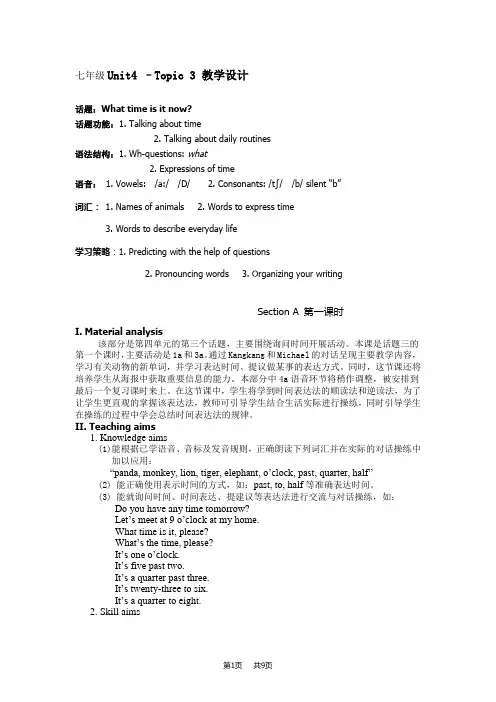
七年级Unit4 –Topic 3 教学设计话题:What time is it now?话题功能:1. Talking about time2. Talking about daily routines语法结构:1. Wh-questions: what2. Expressions of time语音:1. Vowels: /a:/ /D/ 2. Consonants: /t∫/ /b/ silent “b”词汇:1. Names of animals 2. Words to express time3. Words to describe everyday life学习策略:1. Predicting with the help of questions2. Pronouncing words3. Organizing your writingSection A 第一课时I. Material analysis该部分是第四单元的第三个话题,主要围绕询问时间开展活动。
本课是话题三的第一个课时,主要活动是1a和3a。
通过Kangkang和Michael的对话呈现主要教学内容,学习有关动物的新单词,并学习表达时间、提议做某事的表达方式。
同时,这节课还将培养学生从海报中获取重要信息的能力。
本部分中4a语音环节将稍作调整,被安排到最后一个复习课时来上。
在这节课中,学生将学到时间表达法的顺读法和逆读法,为了让学生更直观的掌握该表达法,教师可引导学生结合生活实际进行操练,同时引导学生在操练的过程中学会总结时间表达法的规律。
II. Teaching aims1. Knowledge aims(1)能根据已学语音、音标及发音规则,正确朗读下列词汇并在实际的对话操练中加以应用:“panda, monkey, lion, tiger, elephant, o’clock, past, quarter, half”(2) 能正确使用表示时间的方式,如:past, to, half等准确表达时间。
仁爱版七年级上册英语导学案:Unit4 Topic 3 What time is it Secti
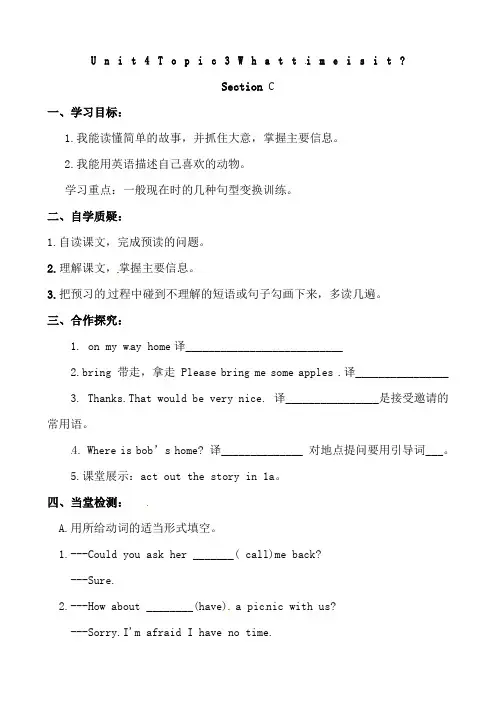
U n i t4T o p i c3W h a t t i m e i s i t?Section C一、学习目标:1.我能读懂简单的故事,并抓住大意,掌握主要信息。
2.我能用英语描述自己喜欢的动物。
学习重点:一般现在时的几种句型变换训练。
二、自学质疑:1.自读课文,完成预读的问题。
2.理解课文,掌握主要信息。
3.把预习的过程中碰到不理解的短语或句子勾画下来,多读几遍。
三、合作探究:1. on my way home译___________________________2.bring 带走,拿走 Please bring me some apples .译________________3. Thanks.That would be very nice. 译________________是接受邀请的常用语。
4. Where is bob’s home? 译______________ 对地点提问要用引导词___。
5.课堂展示:act out the story in 1a。
四、当堂检测:A.用所给动词的适当形式填空。
1.---Could you ask her _______( call)me back?---Sure.2.---How about ________(have) a picnic with us?---Sorry.I'm afraid I have no time.3.I want_______( do) some shopping.4. ---Would you like to go ______( fish)with me?---Yes .I'd like to.5.I'd like ______(fly)a kite with you.五、课堂小结1.通过____学习,我掌握新单词_:______________________。
2.通过____学习,我们组掌握的重点短语和句型有:______________________________________________________ 3.通过____学习,我们组掌握的交际用语有:_____________________________________________________ _____________________________________________________。
七年级英语上册Unit4 Topic3 SectionD精品学案 最新仁爱版
Unit4 Topic3 SectionD 精品学案课型:复习课课时:1课时主备人:一、学习目标:知识与技能:(1)复习时间的表达。
(2)复习有用的句子表达。
(3)进一步谈论时间及日常活动。
二、过程与方法:三、情感态度与价值观:培养学生珍惜时间。
四、学习重点难点:(1)复习时间表达,运用。
(2)谈论一天的日常活动。
I. 课前自主预习案一、过词汇、短语关(一)在家拼读并听写P97-108单词。
(二)找出下列重点单词和短语, 并在课文中勾画出来。
(1) 起床____________________(2) 吃午餐____________________(3) 回家____________________(4) 去学校___________________(5) 放风筝____________________(6) 吃晚餐____________________(7) 跟着……跑、在……身后跑____________________(8) 切掉、切断二、复习时间的提问方式及表达。
完成P103 grammar。
三、反复朗读P103 Functions 5分钟。
II. 高效导、学课堂案Task 1 导入语:(1分钟)(教师自己设计)Task 2 自主学习,质疑交流:(小组活动)(课堂上开始8分钟)(一)自主学习:1.个人大声拼读自主预习案中的词汇、短语和Grammar部分。
2. 组长大声带读,组员大声跟读。
3. 组长抽查组员的认读情况。
4. 然后由两人一组,互相检查自主预习案中的词汇、短语情况。
5.小组展示。
(优:★良:△待优:○ )(二)质疑交流/展示(在预习中自己认为难读的单词、短语或其他):______________________________________________________________________ Task 3 活动探究(听说读写),解惑释疑(18分钟)(一)听P104 歌曲,学唱歌曲。
仁爱版七年级英语上册导学案:Unit 4 Topic 3-Section D.
Unit 4 Having Fun-Topic 3-Section D【学习目标】1、学习的任务和目标:1).知识:学习双音节组合的拼读方法~。
2).方法:(直观法)直接告诉学生是有一个单元音滑向另一个元音。
3).情感:归纳总结本话题的主要内容,让学生自己互相交流本话题学完后的情感触动。
2、学习的重点:掌握单元音和双元音的发音技巧和写法,掌握一般现在时。
3、学习的难点:4、掌握单元音和双元音的发音技巧和写法,掌握一般现在时。
【学习过程】Step 1: 自主学习----明确目标自学文本1. 请同学们课前上平台阅读思考本节导学案,明确本节课的学习任务和目标。
2. 对照课本后面第四单元跟读单词录音。
要求:根据录音及单词音标,首先会读单词接着边读边写记单词,注意中英文的转换,最后默写单词。
3. 独立认真地预习课文。
4. 在线上对照导学案本课时完成探究归纳部分的预习。
5. 请大家带着问题自学本课时的两个微课视频。
Step 2: 自学检测----在线测学质疑思学1. 学生独立完成导学案上的自学检测。
2. 学生在线上提交客观题的答案。
3. 对照正确的答案对错题进行反思,质疑。
1. 通过自学完成下列任务:自学检测题I 词汇A. 根据句意及首字母提示填词。
1.You can see many a____ in the zoo, like elephants and monkeys.2. The l____ is the king of the jungle(丛林之王).3. Twenty-four h____ is a day.4. T____ is Sunday and tomorrow is Monday(星期一).5. My little brother is one year old. He can read many words. He is very c____.B. 根据句意及汉语提示补全句子。
6. Li Ming, it’s time to _____ _____ (起床).7. —Do you have any free time tomorrow?—Yes. _____ _____ (怎么了)?8. —I often _____ _____ (回家) at 6:00 in the evening. What about you, Li Sha? —Me, too.9. The baby can’t find his _____ _____ (回家的路) on Sundays.10.—_____ we _____ (到了). This is my home. Come in, please.Step3: 自展提升----合作探究展示交流通过老师和同学的一起合作交流,解决学生自学中的疑问【知识探究】一般现在时谓语动词的单数形式. 当主语是第三人称单数时,动词有以下变化: (1)一般动词在词尾加s. 如:He likes pandas. 他喜欢熊猫。
【仁爱英语 七年级上册】unit4_topic3_sectiond_教学设计
Unit4 Topic3 SectionD 教学设计I. Material analysis本课是话题三的第四课时,主要活动是Grammar和Functions。
Grammar 部分通过教师引导学生自主总结由what引导的询问时间的特殊疑问句和时间的不同表达方式;Functions旨在引导学生总结Sections A-C所学的表达提议做某事、表达焦虑、动物特征描述、寻求帮助、感谢他人帮助等功能的表达法。
另外,通过听音、填空的活动,巩固关于时间的表达法,并能在时间的不同表达方式进行转换;还将通过听英文歌曲选择标题,理解歌曲的大意。
培养学生通过标题获取文章大意的能力,并在此基础上让学生学唱歌曲,享受学习英语的快乐。
综合探究活动中,通过画出加菲猫的日常安排并用此描述它的日常活动,巩固本话题所学的表达时间和描述日常活动安排的词语与句型,培养学生在真实情景中综合运用本话题所学知识的能力。
II. Teaching aims1. Knowledge aims引导学生巩固和总结由what引导的询问时间的特殊疑问句和时间的不同表达方式;能就表达提议做某事、表达焦虑、动物特征描述、寻求帮助、感谢他人帮助等功能的表达法进行交流与对话操练,如:1Do you have any time tomorrow?Let’s meet at 9 o’clock at my home.They are cute/strong/clever.They are so kind and they have long noses.What’s up, Baby Monkey?I can’t find my way home.It’s very kind of you.Thank you for your help.2. Skill aims能听懂简单的课堂用语并做出适当的反应;能听懂描述及询问时间的表达;能使用问答时间的句型进行简单的交流;能在教师的指导下进行简单的角色表演、仿编对话等;能在口头表达中做到发音清晰,语音语调准确;能大声、准确地朗读课文、演唱歌曲等;2能理解并执行有关学习活动的简单书面指令;能正确书写单词,并能正确使用单词造句;能够运用本话题的句型进行日常活动时间安排的短文写作。
仁爱版7年级上 Unit 4 Topic 3 Section D学案
仁爱版7年级上Unit 4 Topic 3 Section D学案一.学习内容1.复习时间的询问和表达。
2.复习提供帮助和动物的表达。
二、学习要求1.Review how to talk about the point of time:(1)—Excuse me , what time is it , please?—It’s one o’clock.(2)—Excuse me, what’s the time, please?—It’s a quarter past one.(It’s one fifteen.)2. Review some useful expressions.①It’s time to go home.②See you next time.③Kangkang meets Baby Monkey on his way home.④What’s wrong with you, Baby Monkey?I can’t find my way home.⑤Here we are.⑥It’s very kind of you.⑦Thank you for your help.三、学习过程(一)课前预习1.课前预习课本P99—100.2. .课前预习同步练习与测试Unit 4 Topic 3 Section D练习(二). 提高拓展的练习Ⅱ. 句型转换1. The boy likes swimming.(改为否定句)The boy swimming.2. What do you want?(改为同义句)What you ?3. The meat is eleven yuan.(对画线部分提问)is the meat?4. I like elephants best.(对画线部分提问)do you like best?Ⅲ. 阅读理解AThere is a big shop near my home. It sells many things. There are many people in this shop every day. There are many people in this shop every day.They are men and women, old and young. They all want to buy something there.It’s Saturday afternoon. Mother and I are in the shop. Mother wants to buy some food for supper this evening. And I want a pen and a ruler. Mother buys half a kilo of meat, a kilo of fish and two kilos of eggs. They are all very cheap. The people in the shop are very friendly. The shop opens early in the morning and close at 8:00 in the evening. People can buy things after work.( )1. People can buy in this big shop.A. only school thingsB. only foodC. a lot of thingsD. only clothes( )2. Meat fish and eggs in this shop .A. not cheapB. aren’t dearC. not cheap at allD. very dear( )3. The shop is open .A. all dayB. only in the morningC. from 8:00 to 2:00D. very dear( )4. Many students can buy school things home.A. on their way toB. in wayC. in the way toD. on their wayBThis is a special class. The students come from different countries.Some come American, others come from Canada, Japan, Australia and England. They speak different languages. But all of them can speak English.They are good friends. They study together, play together and live together.They help each other.All the teachers of this class are Chinese, but they can speak English.They teach their students in English. They are very kind and friendly. They work hard.The students in this class study Chinese cooking and Chinese Gongfu (功夫). All the students like China. They say China is great country and the Chinese people are friendly. And they are happy in China.根据短文判断正误,对的用“T”表示,错的用“F”表示( )5. The students all come from English.( )6. All of them speak the same language.( )7. The teachers of this class teach the students in English.( )8. The students in this class only study Chinese cooking.( )9. The teachers of this class can speak Chinese and English.(三)课后复习1、复习课本P99—100.2、完成同步练习与测试Unit 4 Topic 3 Section D练习(四)自学问题记录:。
- 1、下载文档前请自行甄别文档内容的完整性,平台不提供额外的编辑、内容补充、找答案等附加服务。
- 2、"仅部分预览"的文档,不可在线预览部分如存在完整性等问题,可反馈申请退款(可完整预览的文档不适用该条件!)。
- 3、如文档侵犯您的权益,请联系客服反馈,我们会尽快为您处理(人工客服工作时间:9:00-18:30)。
七年级英语问题导学案编号:
班级:姓名:设计人:包萨初仁贵审核:赛音那木拉黎明苏日古格双风课题:Unit4 Having fun Topic 1 What time is it now? Section D 学习目标: 1. 巩固和总结由what引导的询问时间的特殊疑问句和时间的不同表达方式;
2. 能就表达提议做某事、表达焦虑、动物特征描述、寻求帮助、感谢他人帮助等功能的表达法进行交流与对话操练,如:
能够认真学习、规范单词、句子等;
能够养成保护动物、和大自然和谐相处的意识,并能在现实生活中积极实践。
学习重难点: 1.巩固和总结由what引导的询问时间的特殊疑问句和时间的不同表达方式。
2.能就表达提议做某事、表达焦虑、动物特征描述、寻求帮助、感谢他人帮助
等功能的表达法进行交流与对话操练。
学习过程
1.学习新单词,并用其造句。
2.独立完成grammar和functions部分,试着自己总结归纳topic3所学的重点内容。
3.认真读并完成学案“预习指导”。
4.听短文完成1a,1b。
5.听歌曲选择最适合的歌名。
6.完成学案第一,二题。
7.完成学案第三题。
Ⅰ根据汉语意思写单词。
熊猫______猴子________ 狮子_____老虎_____大________
5:00___________ 8:35______________ 11:08_____________
10:45______________7:15_____________9:55_____________ Ⅱ. 翻译句子。
1.现在是回家的时候了。
___ ____ ____ ___ _____.
2.Everyday we have breakfast at 6:40, and have lunch at 12:00.
___________________________________________
Ⅲ.按要求改写句子。
(1)It’s time for supper.(同义句) It’s time ___ ___ ___.
一、What time is it? (同上) What is ____ ____?
二、What animal do you like best?(同上)
What is your ____ ____?
三、This is Baby Monkey’s home( 对划线部分提问)
____home ___ this?
四、It’s a quarter to four. (同上)
____ ____ is it ?
Ⅳ.用所给词的适当形式填空。
[中国~@^教#&育出版网]
(1)Jim,It’s time ____(do) some shopping.
(2)How about ____(have) a banana? ---Good idea![来源~:中%@教#网&] (3 ) What’s wrong with you ,little boy?
--- I can’t ___ (find) my mother.
(4) It’s 2:30 in the afternoon. Let’s ____(go)fishing.
(5) —Would you like____(go) to t he zoo?
---Yes, I want ____(see)anima ls.[来#源:~中国%&教育@出版网]
(6)Mr. Li _____ (teach) Chinese in our school.
(7)Pandas live in ______ (Chinese).
(8)Thanks for us _______(help)me.
(9)It’s time for us _____ (clean) the room.
(10)My mother often_____ ( go) to bed at ten.。
